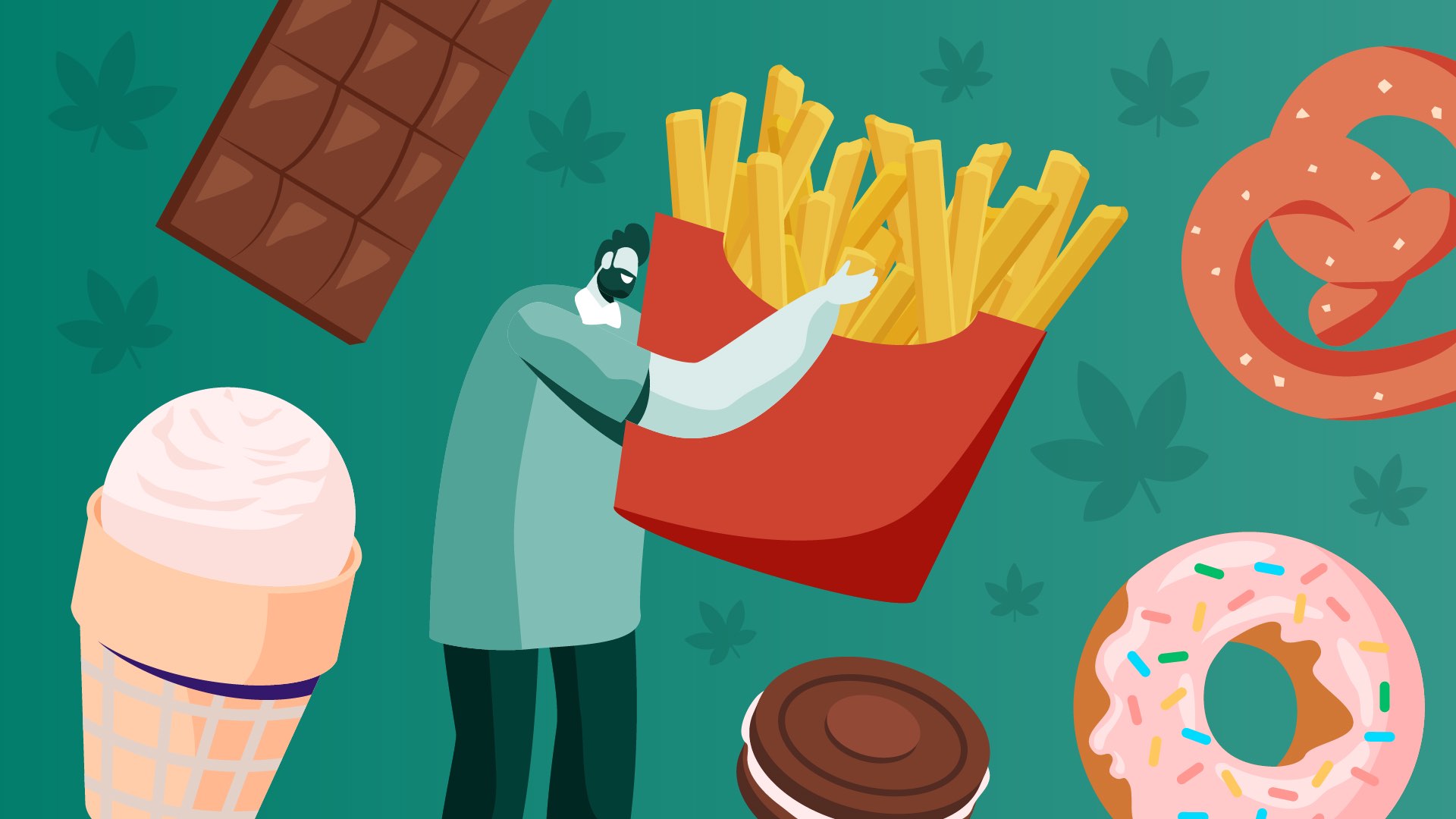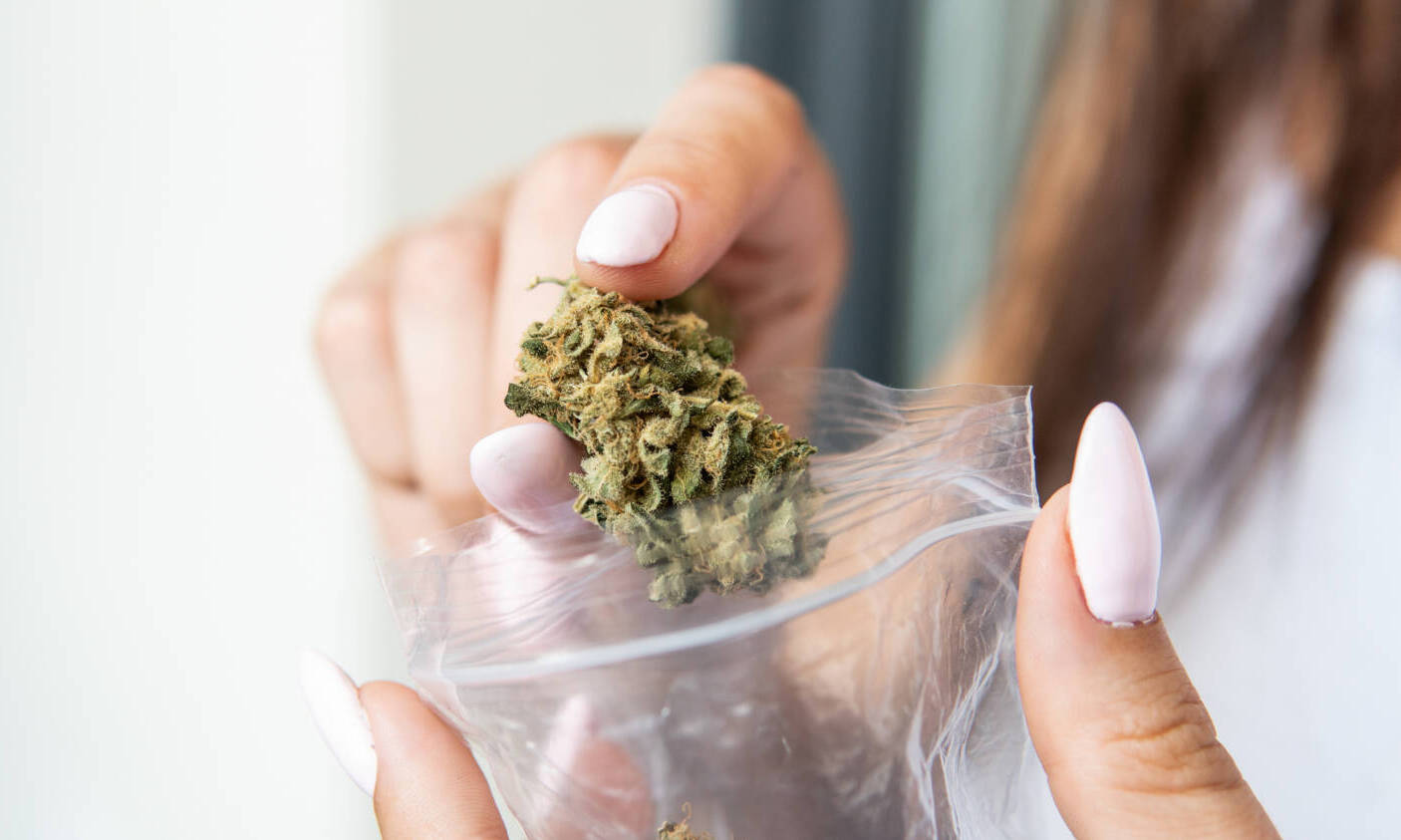You really are what you eat, Leafly reader. We know that after you smoke weed, you will eat more in the moment—but as it turns out, you won’t necessarily gain weight in the long-run. Hey, the neuroscience of hunger and weed is complicated. Just in time for turkey day, Leafly’s Nick Jikomes, PhD, provides dietary tips for mind and body, as well as how cannabis fits in.
‘Mind & Matter’ is a column by Nick Jikomes, PhD, Leafly’s Director of Science & Innovation and creator of the Mind & Matter podcast. Disclaimer: none of this content is medical advice.
One of the most famous and well-known effects of cannabis is “the munchies.” THC can cause food to taste better and motivates us to eat highly palatable (tasty), calorie-rich foods. This effect comes from THC stimulating CB1 receptors in the brain, an effect seen across many species. Endogenous cannabinoids—important fat-like signaling molecules in the body—have a similar effect: higher overall levels of endocannabinoids are associated with increased feeding and weight gain, and injecting endocannabinoids into specific regions of the brain stimulates food intake.
The endocannabinoid system regulates whole-body metabolism, not just eating per se. Cannabinoids regulate many aspects of metabolism via the CB1 receptor, the same receptor THC engages to produce the psychoactive effects of marijuana. The metabolic effects of cannabinoids include fat synthesis in the liver, insulin secretion by the pancreas, and the use of sugar by muscles. In general, research indicates that increased stimulation of the endocannabinoid system through CB1 receptors mobilizes the body’s tissues to accumulate energy reserves. Basically, greater activation of CB1 receptors (read, consuming THC) tells the body to consume calories and store them up for later use.
Fat cells in the body also express CB1 receptors. Cannabinoids can therefore directly influence body fat, often enhancing fat storage. There is a strong correlation between visceral fat and endocannabinoid levels in the body, and excessively high levels of endogenous cannabinoids are associated with diet-induced obesity and poor metabolic health.
Related
How to stop the munchies when you’re high
Cannabinoid receptors are also expressed in key metabolic organs like the liver. Consuming cannabinoids such as THC, or changing your endocannabinoid levels via diet (more on that below), causes more than psychoactive effects in the brain; they influence not just your propensity to eat, but how your body utilizes what you consume.
Cannabinoids also influence gut-brain interactions via the microbiome, a new and active area of research. To learn more, check out my conversation with microbiologist Dr. Christoph Thaiss:
In general, stimulation of CB1 receptors by cannabinoids tends to have these metabolic effects in the short-term:
- Increased food intake
- Increased lipogenesis (fat synthesis) in the liver
- Increased insulin secretion by the pancreas
- Increased nutrient absorption by the GI tract
- Increased glucose metabolism in muscle
- Accumulation of fat in adipose tissue
A less commonly talked about subject is how diet itself, especially fat content, influences the endocannabinoid system.
How diet influences endocannabinoids: Omega-3 vs omega-6 fats
Cannabinoids don’t just influence our hunger levels and food cravings; what we eat influences endogenous cannabinoids within our bodies. Endocannabinoids are small, fatty molecules made from linoleic acid, an essential omega-6 fatty acid. We have to eat essential fatty acids via diet because our bodies don’t produce them.
Shop highly rated dispensaries near you
Showing you dispensaries near
Because endocannabinoids are derived from omega-6 fats, a diet higher in omega-6 content tends to result in higher endocannabinoid levels. The typical “Western diet” contains excessively high levels of omega-6 fats and low levels of another essential fatty acid, omega-3s, which are associated with elevated endocannabinoid levels.
The composition of Western diets has been changing for centuries. Compared to our Paleolithic ancestors, modern people have been getting more of their calories from fat. Since the early 1900s, dietary fat composition has dramatically changed. Increases in production of soybean and seed oils have driven large increases in consumption of omega-6-rich fats, paralleled by reductions in animal fats (e.g. butter, lard), which tend to be higher in other fat types.
The obesity epidemic emerged in Westernized countries around the 1980s. Since then, fat consumption has peaked or even declined somewhat, but with the continued trend of increases in omega-6 fat consumption. Today, Americans routinely consume omega-6 and omega-3 fats at a ratio of 20:1 or higher. For most of human prehistory, this ratio was closer to 1:1.
Omega-6 fats are common in processed foods and anything cooked or produced using cheap vegetable and seed oils, which are often high in linoleic acid.
Changes in the balance of dietary omega-6 and omega-3 fatty acids have links to a variety of consequential health outcomes. In general, diets very high in omega-6 fats and low in omega-3s are associated with greater systemic inflammation, fat accumulation and obesity, and insulin resistance–poor metabolic health.
Since endocannabinoids generally stimulate food intake, elevated endocannabinoid levels resulting from a high omega-6 fat diet would then increase feeding. It’s easy to see how a vicious cycle could form: a high omega-6 diet leads to weight gain and poor overall metabolic health, which elevates endocannabinoid levels and stimulates further food intake. Not good.
Making dietary changes
To promote better metabolic health, you may need to reduce your omega-6 and increase omega-3 intake. Omega-6 fats are common in processed foods and anything cooked or produced using cheap vegetable and seed oils, which are often high in linoleic acid. Avoid using cooking oils like grapeseed, sesame, and sunflower oil when preparing meals, and minimize processed food consumption.
Eating omega-3-rich foods, by comparison, can help maintain healthy endocannabinoid function in the brain. Foods high in omega-3s include various seafoods (e.g. salmon, oysters), chia seeds, and walnuts. Fresh, cold-water marine animals have the highest omega-3 content.
Endocannabinoids are critical for proper brain functions like neuroplasticity. In animals, omega-3 deficiency can abolish forms of neuroplasticity which depend on endocannabinoids, and low levels of omega-3 are linked to numerous psychiatric diseases.
Related
The Stoner Diet: How Getting High Will Help You Eat Your Veggies
Here’s a summary of the key points around how dietary fat influences endocannabinoid levels and metabolic health:
- Endocannabinoids are produced from omega-6 fats. Diets high in omega-6 fatty acids increase endocannabinoid levels.
- A high omega-6 fat diet is characteristic of the typical Western diet, and has correlations with high endocannabinoid levels, weight gain, inflammation, and poor metabolic health.
- Omega-3 fats are critical for endocannabinoid function in the brain. Diets deficient in omega-3s can lead to deficits in endocannabinoid-related brain function.
- A diet with balanced levels of omega-6 and omega-3 fatty acids is generally desirable.
So why is chronic THC exposure associated with weight loss, not weight gain?
Acute cannabis consumption stimulates appetite and eating (“the munchies”), due to THC activating the CB1 receptor, the same receptor endocannabinoids activate to drive eating. National surveys, however, have found a lower prevalence of obesity in cannabis users compared to non-users. Why would chronic cannabis use be associated with lower rates of obesity if cannabinoids like THC stimulate eating?
One explanation is that the association between cannabis use and lower obesity rates is not real.
It may be that these simple surveys cannot adequately control for all relevant variables. To assess whether correlations like this might represent a real relationship, cause-and-effect experiments in rodents where diet and THC consumption are controlled indicate that chronic THC consumption actually protects against weight gain. In rodents with diet-induced obesity, chronic THC exposure leads to less weight and fat mass gain, as well as lower energy intake. This effect may come, in part, from alterations to the gut microbiome.
To learn more about the relationship between THC consumption, feeding, and weight gain, see my conversation with Dr. Saoirse O’Sullivan:
Rodents aren’t humans, of course, but cannabis research on humans faces a mountain of regulatory, funding and clinical barriers. Assuming the link between chronic THC consumption and lower rates of obesity holds true in humans, how can we explain this?
One theory is tolerance. Chronic THC exposure likely leads to a decrease in the number of CB1 receptors on neurons, or a decrease in their sensitivity. This would leave fewer CB1 receptors available for stimulation by endogenous cannabinoids. Because increases in CB1 activation lead to feeding and weight gain, fewer CB1 receptors might result in less overall CB1 activation and therefore lower levels of feeding (except with strong CB1 activation by consumption of high levels of THC).
Related
Does weed make you lose weight?
If chronic cannabis stimulation of CB1 receptors leads to weight gain, shouldn’t drugs with the opposite effect on CB1 receptors have the opposite effect (weight loss)? This was exactly the thinking behind Rimonabant, an anti-obesity drug developed in the 2000s with the opposite effect on CB1 receptors as THC and endocannabinoids.
Rimonabant had the intended primary effect of facilitating weight loss in obese patients, but it was pulled from the market due to the prevalence of severe side effects. It caused depression or mood alterations in ~10% of patients, suicidal ideation in ~1%, and nauseas and respiratory tract infections in >10%. Other common side effects included gastroenteritis (infectious diarrhea), anxiety, irritability, sleep disturbances, and more.
Why? Because the endocannabinoid system is a whole-body system and CB1 receptors are found in diverse tissues throughout the body. A drug that blocks CB1 receptors will usually block them everywhere. This will affect all of the related biology, not just the specific piece we want to change.
The nutrients we consume as fuel also act as signaling molecules that influence cell function.
A far safer alternative to pharmaceuticals is proactive management of your diet. Food is not simply calories. The nutrients we consume as fuel also act as signaling molecules that influence cell function. As with endogenous cannabinoids, macronutrients like fat help facilitate critical messengers in the body that orchestrate how we process what we consume—a gram of fat from one source can have very different metabolic effect than a gram of fat from another. Furthermore, many drugs and foods affect key liver enzymes, which metabolize a wide range of other substances.
Actively managing your metabolic health by tracking nutrients takes time, effort, and willpower. Processed foods, such as omega-6-rich cooking oils, are cheaper and easier to acquire than alternatives, but they interfere with the body’s natural satiety mechanisms. They also have economic incentives to lack true satiation. It’s in the food processor’s interest for you to finish your bag of chips quickly, stay hungry, and then buy another.
Armies of industry food scientists have worked for years to come up with clever ways of hacking our biology. This can lead to eating beyond your body’s true caloric and nutritive needs, costing you not only your health but an enormous amount of lifetime dollars; besides more costly grocery runs, people with obesity have significantly higher medical costs.
What you consume, including both food and drugs, influences who you become. This is not just flowery language: you are physically built from what you consume, and what you consume influences how your body uses the building blocks you provide to it. Choose wisely.


















































